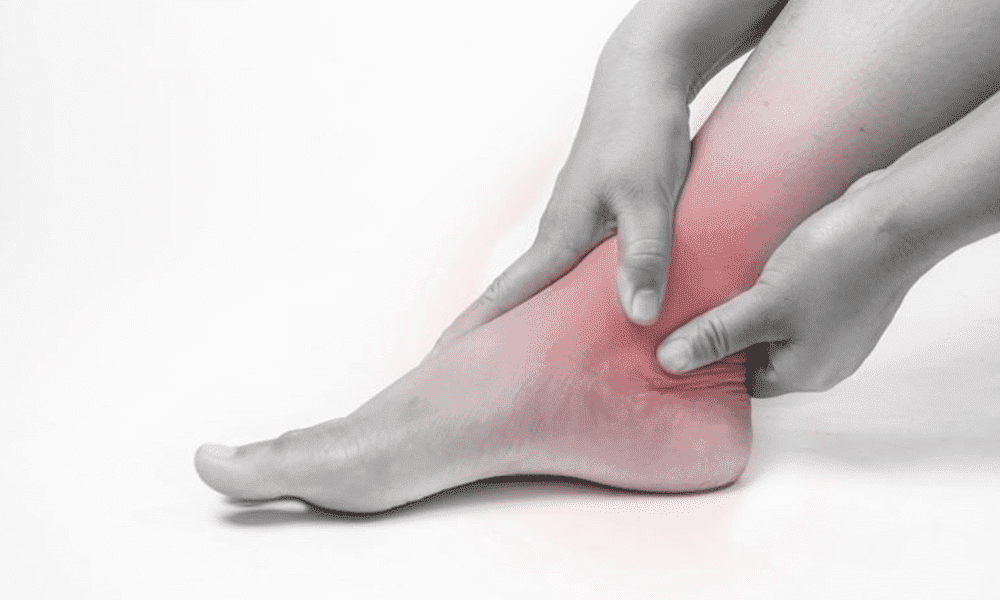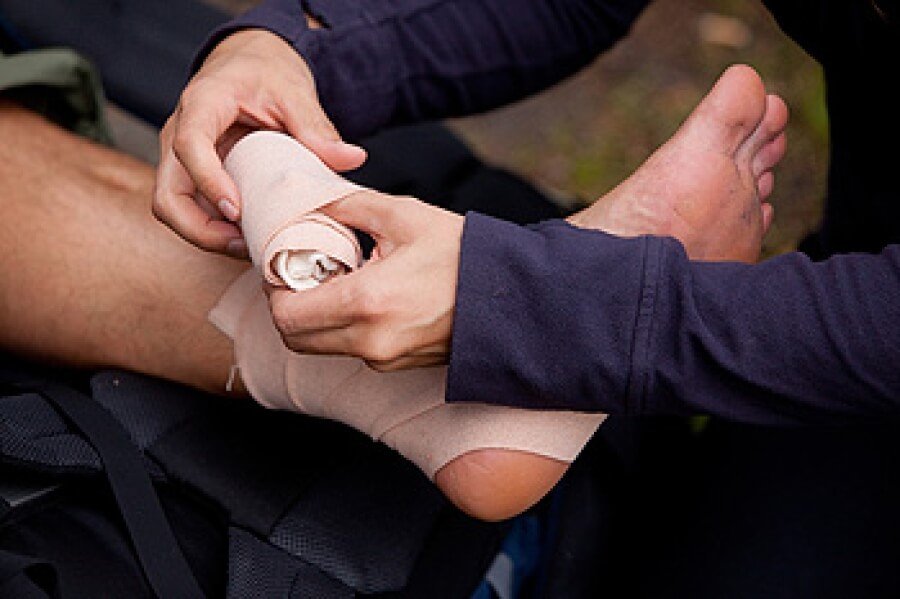Stepping Through Recovery: Understanding and Treating Ankle Sprains

FOOT & ANKLE SURGEONS OF KANSAS
ANKLE SPRAINS SURGERY Q&A

WHAT ARE ANKLE SPRAINS?
Ankle sprains occur when the ligaments supporting the ankle joint are stretched or torn beyond their normal range of motion. Ligaments are strong bands of tissue connecting bones, providing stability to the joint. When damaged, they can cause swelling, pain, bruising, and instability in the ankle.
There are three main types of ankle sprains:
- Inversion Ankle Sprain: This is the most common type. It occurs when the foot rolls inward, causing the ligaments on the outside of the ankle to stretch or tear.
- Eversion Sprain: Eversion sprain occurs when the foot rolls outward, causing the ligaments on the inside of the ankle to stretch or tear.
- High Ankle Sprain: High ankle sprain occurs when the ankle joint is forced beyond its normal range of motion in any direction. High ankle sprains are often more severe than inversion or eversion sprains.

Common Symptoms of Ankle Sprains
- Pain :Pain is the most common symptom of an ankle sprain. It is usually felt around the outside of the ankle, but it can also be felt on the inside or back of the ankle. The pain may be sharp and stabbing at first, and then become dull and aching as the injury heals.
- Swelling: Swelling is another common symptom of an ankle sprain. It is caused by inflammation and fluid accumulation in the damaged ligaments and tissues. It can take a few days or even weeks for the swelling to subside completely, depending on the severity of the injury.
- Bruising: Bruising is caused by bleeding from the damaged ligaments and tissues. It may appear as a discoloration of the ankle that is blue, purple, or black. The bruise may not appear immediately after the injury and may take a few days to reach its peak color.
- Difficulty Walking: It may be difficult or painful to walk after an ankle sprain. This is because the pain, swelling, and instability of the ankle joint can make it difficult to put weight on the injured foot.
- Instability: The ankle joint may feel unstable or like it is “giving way” after an ankle sprain. This is because the injured ligaments are not able to provide the same level of support as they did before the injury.
- Tenderness to the Touch: The ankle may be tender to the touch, especially around the area of the injured ligaments.
- Limited Range of Motion: The range of motion of the ankle joint may be limited after an ankle sprain. This is because the pain and swelling may restrict the ankle joint’s ability to move in all directions.

Is my ankle sprained? What are the risk factors?
- Previous Ankle Sprains : Individuals who have previously experienced ankle sprains are more susceptible to future sprains. Once the ligaments are stretched or torn, they may be more prone to injury.
- Inadequate Warm-up or Stretching: Insufficient warm-up before engaging in physical activity or inadequate stretching can make the muscles and ligaments less flexible, increasing the risk of sprains during activity.
- Poor Footwear: Wearing ill-fitting footwear with inadequate support can contribute to ankle instability and increase the risk of sprains.
- Terrain and Playing Surface: Uneven terrain, irregular surfaces, or playing sports on surfaces with poor traction increase the risk of twisting the ankle and sustaining a sprain in your ankle.
- Sports Participation: Certain sports, such as basketball, soccer, and volleyball, involve frequent changes in direction, jumping, and sudden stops, making participants more susceptible to ankle sprains.
- Muscle Weakness or Imbalances: Weak or imbalanced muscles surrounding the ankle may not provide adequate support, making the joint more vulnerable to sprains.
- Anatomic Factors: Individual variations in ankle anatomy, such as high arches or flat feet, can affect the distribution of forces on the ankle and contribute to instability of ankle.

HOW ARE ANKLE SPRAINS DIAGNOSED?
Diagnosing an ankle sprain typically involves a deeper evaluation by a healthcare provider, including a thorough medical history, physical examination, and imaging studies if necessary.
1. Medical History : Our healthcare provider will collect information about the mechanism of injury, including the activity being performed, the specific movement that caused the sprain, or any immediate sensations or sounds experienced. They will also inquire about any previous ankle pain, chronic ankle sprain treatments, medications, and overall activity level.
2. Physical Examination : The physical examination is crucial for assessing the extent of the ankle injury. Our healthcare provider will observe the injured ankle for swelling, bruising, and any visible deformities. They will feel the ankle joint to identify areas of tenderness and instability. They will also assess the range of motion of the ankle joint, comparing it to the unaffected ankle.
3. Imaging Studies : While imaging studies are not always necessary for diagnosing ankle sprains, they may be ordered to rule out more serious injuries, such as bone fractures or ligament tears.
- X-rays: X-rays are used to visualize bones and can effectively detect fractures but do not show soft tissue injuries like ligaments.
- Magnetic Resonance Imaging (MRI): MRI provides detailed images of soft tissues, including ligaments, tendons, and cartilage, allowing for a more comprehensive assessment of ligament damage.
4. Grading the Severity : Ankle sprains are graded based on the severity of ligament damage :
- Grade I: Mild sprain with minimal ligament stretching and tenderness.
- Grade II: Moderate sprain with partial ligament tearing, moderate swelling, and instability.
- Grade III: Severe sprain with complete ligament tearing, significant swelling, and instability.
The combination of clinical assessment and imaging findings allows our healthcare providers to accurately diagnose the type and severity of the ankle sprain. Accurate diagnosis is key for effective ankle recovery and preventing complications. This information guides the development of an appropriate treatment plan tailored to the individual’s needs. It’s crucial to seek medical attention for a proper diagnosis, as other conditions, such as fractures or joint injuries.

HOW ARE ANKLE SPRAINS TREATED?
The sprained ankle treatment typically involves a combination of conservative measures and, in some cases, surgical intervention. The specific treatment plan will depend on the severity of the sprain and the individual’s overall health.
Here’s an overview of how ankle sprains are typically treated:
- RICE Protocol: The RICE protocol is the initial treatment for most of the ankle sprains, regardless of severity. It stands for Rest, Ice, Compression, and Elevation.
- Rest :Avoid putting weight on the injured ankle and allow it to heal.
- Ice :Apply ice packs to the injured ankle for 15-20 minutes at a time, several times a day, to avoid swelling and pain in the ankle.
- Compression : Use an elastic bandage to wrap the injured ankle firmly to help reduce swelling on it.
- Elevation : Elevate the injured ankle above the level of the heart to help reduce swelling on your ankle.
- Compression and Support : Compression and support can be provided by an elastic bandage, an ankle brace, or a walking boot. These devices help to immobilize the ankle joint and provide support during healing.
- Pain Medication : Over-the-counter pain relievers can help to reduce pain and inflammation. In some serious cases, a prescription pain medication may be necessary.
- Physical Therapy: Once the initial swelling and pain have subsided, physical therapy can help to restore range of mobility, strength, and stability to the ankle joint. Physical therapists will teach you exercises to strengthen the muscles around the ankle and improve coordination.
- Surgery:Surgery is rarely necessary but in cases of severe sprains, surgery may be considered to repair torn ligaments or to correct instability in the ankle joint.
- Recovery: The ankle recovery time varies depending on the severity of the injury. Mild sprains may heal in a few weeks, while severe sprains may take several months to heal.
Preventing Ankle Sprains
To minimize your risk:
- Warm up and stretch before physical activity.
- Strengthen the muscles around your ankles through targeted exercises.
- Wear supportive footwear suitable for your activities.
- Use braces or tape if you have a history of ankle injuries.



